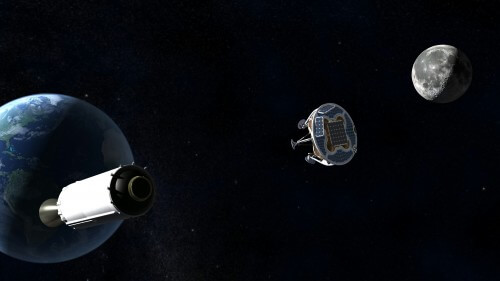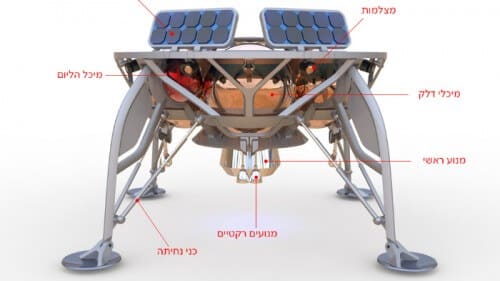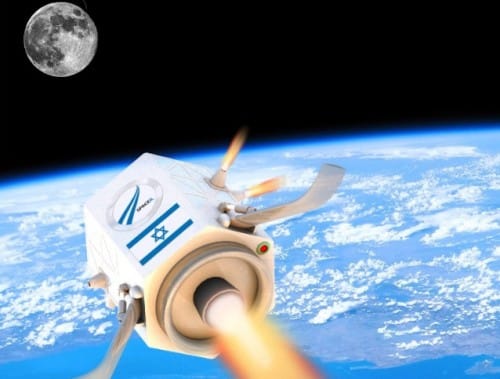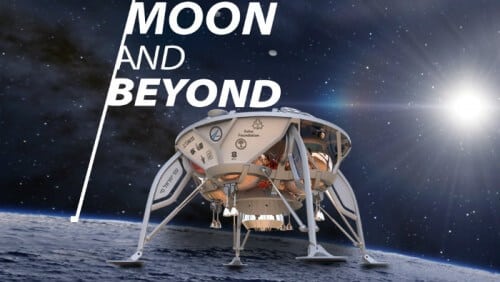In doing so, SpaceIL is expected to be the first team among the competitors in the Lunar X prize competition to launch a spacecraft to the moon. If the launch does not fail and the spacecraft performs its mission, it may also win a prize worth 30 million dollars, which will cover about 60% of the investment

The SpaceIL association signed a contract to launch the first Israeli spacecraft intended to land on the moon, as part of Google's Lunar X prize competition. The Israeli spacecraft will be launched into space on a Falcon-9 rocket of the private space company SpaceX, and the planned launch date is in about two years - the end of 2017.
An educational project
The SpaceIL association was established at the end of 2010, to participate in Google's competition. The site was the launch of a spacecraft that would land on the moon, take off from it and jump to another point, and of course transmit broadcasts from there. Now 16 teams from around the world participate in the competition, and the Israeli team is the first to reach a launch contract, which makes it a leading candidate to win the prize offered by Google - 30 million dollars. However, the award - if they do win it - will cover only part of the association's expenses, whose general budget currently stands at about 50 million dollars. Most of the budget is intended to finance the launch, which is expected to cost about 20 million dollars according to experts.
Even though SpaceIL is an advanced technological-engineering enterprise, its founders see it first and foremost as an educational enterprise, designed to bring especially young people closer to science. "We looked at what happened when Apollo landed on the moon, when the youth were excited about science and engineering, and we realized that this is our goal," says Kafir Demari, one of the founders of SpaceIL and vice president of the association. "We want to use our landing as a tool to show teenagers that science and engineering is fun, it's amazing, it's the way to change the world, hoping to convince some of them to be the ones to build the next spacecraft."

The new model of the Israeli spacecraft to the moon, SpaceIL

Following the superpowers
As mentioned, the Israeli spacecraft will be launched on a private American rocket, which will carry a large group of spacecraft and satellites into space. However, while most of them will be released from it at an altitude of several hundred kilometers, the Israeli spacecraft will continue to soar with the missile, to an altitude of tens of thousands of kilometers - about a tenth of the way to the moon. It will circle the earth several times (the exact number will be determined according to the launch date, because the position of the moon changes all the time, of course), and at the right moment it will activate its rocket engines, and go on a journey of about four days until it enters orbit around the moon. She is also expected to stay on this route for a few days until the appropriate timing arrives at the intended landing site.
The completion of the launch contract, which precisely determines the dimensions of the spacecraft (which weighs about 500 kg, mostly fuel and fuel tanks), allowed the SpaceIL engineers to redesign the spacecraft, for the final design, the model images of which appear here. Now they have a lot of work ahead of them to complete its construction for the launch date. "We have been waiting for this moment for years, to close the launch", says Demari. "Today was a moment of excitement and joy, and from now on we must increase the pace of work even more", he concludes.
If the project is successful, the Israeli association will join the USA, the USSR and China - the only ones that have so far succeeded in landing spacecraft on the moon. This probably proves that in space - as in other fields - not only size matters...
More of the topic in Hayadan:
- SpaceIL signed an agreement to purchase a ground station
- SpaceIL purchases engines for the spacecraft at the MLM plant of the aerospace industry
- SpaceIL received a $16.5 million donation from the Adelson family
Text of the SpaceIL press release
At a press conference held today (October 7.10) at the President's House, in the presence of President Reuven Rivlin and Minister of Science, Technology and Space Ofir Akunis, SpaceIL revealed that it had secured its place on the launch rocket of the American space giant SpaceX, owned by Elon Musk.
SpaceIL signed a launch contract on a rocket of the American company at a cost of over 10 million dollars, and this is thanks to the completion of another fundraising round from its two main donors: the Kahn Foundation, owned by Maurice Kahn, and the Dr. Miriam and Sheldon C. Family Foundation. Adelson, and thanks to the impressive engineering progress made in the design and construction of the spacecraft, which allows it to commit to the expected launch date at the end of 2017.
Israel's SpaceIL is the first and only group so far to reach the dramatic milestone of signing an agreement and securing a space on the launch pad. This means that, as of now, SpaceIL leads the international race to land an unmanned spacecraft on the moon and even becomes the group with the greatest chances of winning the Google Lunar XPRIZE competition. It should be noted that 33 private companies from all over the world originally registered for the competition, but most of them withdrew and only 15 teams still remained in the challenge.
The chairman of the competition organizer, the XPRIZE Foundation, Bob Wise confirmed at the event that the Israeli team is the only team that signed a launch agreement and is therefore the leading team in the competition, and wished SpaceIL success in their journey to the moon.
The chairman of SpaceIL, Yanki Margalit: "Thanks to the signing of the launch agreement, SpaceIL is bringing the State of Israel closer to what was until now the exclusive domain of the three superpowers - the USA, the Soviet Union and China - landing on the moon. This is an extraordinary achievement at both the national and international level; SpaceIL, which was the last group to register for the competition, is now in a distinct advantage over strong groups from countries rich in knowledge and capital."
"In the past year, we have come a long way towards landing on the moon, both in terms of financing the project and in terms of engineering planning - and even in recent months, the first components of the spacecraft began to physically arrive at SpaceIL's integration laboratory," noted SpaceIL CEO Dr. Eran Pribman and explained Because SpaceIL, unlike the other groups that built large and heavy space vehicles, found an engineering solution that significantly reduces launch costs: the Israeli spacecraft is smart and small in size, therefore allowing SpaceIL to be content with purchasing a specific cell on the launcher, unlike the other groups, which had to To purchase the entire launch at very high costs."
SpaceIL engineers recently finished designing a new and improved model of the spacecraft. The weight of the spaceship in the new model is about 500 kg at takeoff, most of which comes from fuel intended to allow the spaceship to complete the last segment of the flight to the moon (after separation from the launch rocket), its height is about 1.5 meters and its total width is about 2 meters The spaceship is spread out. With the completion of the new engineering design, SpaceIL realized that the outer appearance of the spaceship, which is expected to become an inspiring national icon, is also important. To this end, they turned to the guidance of the well-known Israeli industrial designer, Alex Padua. The result was revealed today at the press conference.
President Rivlin noted that: "I remember as a child the inscription on the gum wrappers with the wish "By the age of 21 you will reach the moon". It used to seem impossible and you are making it a reality. For the hundreds of thousands of students who have already been exposed to your work, and the millions who will be exposed, you are a model of courage, success, and a vision of breakthrough Israeliness. I wish you great success."


9 תגובות
Thanks for the feedback!!!
The central reactor - uranium the size of an orange - I read in several places. The rods to create a critical mass for the reaction I agree with you, you corrected me.
But logic says that if it works for airplanes, it will work in a spaceship. Water has another advantage. I read that they absorb radiation at a certain thickness (1 meter) and not only lead does this. Again I don't sign it - I don't have time to check.
We both agree, in my opinion, that a closed circuit is needed here, which is not necessary in the matter of airplanes. But it frees the vehicle from an oppressive dependency - a slowly depleting energy source.
The Philae spaceship moves in plasma except for the rocket propulsion to go outside the earth in a rocket. Elon Musk's spaceships that are supposed to be used as Obama's preferred option for space propulsion run on plasma from the moment they are out. This is an application for everything, and that is where the countries of Europe and the USA are moving. It took about 50 years to develop the technology!!! The idea is smart in my opinion: there is no need for a fuel tank that gets bigger with the distance, and the momentum of the particles compensates for the low mass. There are problems here: Philae is more of a satellite and needs propulsion for a vehicle 1000 times larger. The human mind continues to find ways to circumvent limitations.
To Yossi:
An aircraft carrier reactor is about 500 megawatts. You need a lot of oranges - probably several tons. In fact, the fuel is in the form of rods - there is research on fuel in the form of balls, but I am not aware that there is even one such reactor working.
Regarding propulsion by fast ions - there is a lot of research, but there is still no practical use in spacecraft. I wish soon.
On the issue of uranium planes the size of an orange. The reactor is much larger.
Helium is a very incompressible gas being the second (?) element in the periodic table. Spaceships such as Philae that went on a 10-year journey to the hook, are powered by a plasma engine. With a plasma engine, you don't have to haul a train of fuel wagons that gets longer as the journey gets longer, and in addition, you have to turn off engines on the way.
The idea I propose is completely untested. Not looking for the exact details unless general is a reasonable idea.
Plasma is a creation using high voltage (tens of kilovolts) which is not too difficult, of charged particles with a small mass, but a speed close to the speed of light. For example lightning is considered a plasma and lightning models assume movement at speeds close to the speed of light. (For that matter, also a quarter of the speed of light, I don't know exactly). As a result, a significant momentum and forward drive is obtained. The Americans started experimenting with plasma propulsion in about 1965, and actual use is known to me from 2005. I am not precise in the dates but in principle. That is, it took about 40 years to mature the technology. Israel may not have such capabilities, and their development is expensive. A second way of more effective movement that I thought of is through a nuclear engine.
Nuclear reactors know how to heat water to steam, and to cool with water.. Regarding airplanes, a reactor the size of an orange provides energy for 13 years. The ocean has plenty of water for steaming and cooling.
Perhaps it is possible to produce a closed circuit that reuses water. The water will turn into steam at 300 degrees, and the steam will drive generators to produce electricity. The electricity will produce plasma - a stream of electrons for example, and the plasma will move. In the two forms I described you don't need an increasing fuel stock as the distance from Earth increases.
The helium is designed to replace the hydrogen and oxygen in the tanks and thus maintain a constant pressure during engine operation
It is not true what Bob Wise said: "...the chairman of the competition organizer, the XPRIZE Foundation, Bob Wise confirmed at the event that the Israeli team is the only team that signed a launch agreement and is therefore the leading team in the competition, and wished SpaceIL success in their journey to the moon..." 3 more groups have contracts to launch. 2 American and one Japanese, in all other contracts the launch is before the Israeli group. Which puts Israel fourth... according to wikipedia. https://en.wikipedia.org/wiki/Google_Lunar_X_Prize
I hope that this welcome initiative will be used for the expansion of the space industries in Israel.
In other areas where size does not determine, did you mean a male organ?!
Why does the spaceship carry helium?